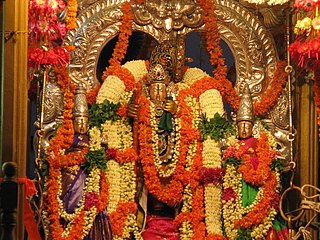Related Research Articles

Alluri Sitarama Raju was an Indian revolutionary who waged an armed rebellion against the British colonial rule in India. Born in present-day Andhra Pradesh, he was involved in opposing the British in response to the 1882 Madras Forest Act that effectively restricted the free movement of adivasis in their forest habitats and prevented them from practicing their traditional form of agriculture called 'podu', which threatened their very way of life. Rise in discontent towards the British colonial rule in the backdrop of the non-cooperation movement (1920–1922) led to the Rampa rebellion (1922–1924) in which Alluri Sitarama Raju played the major role as its leader. Mustering combined forces of tribals and other sympathizers to the cause, he engaged in guerilla campaigns against the British forces across the border regions of present-day Andhra Pradesh and Odisha states in India. He was given the title "Manyam Veerudu" by the local people for his exploits.

The Malabar Special Police (MSP) is an armed police battalion of the State Police of Kerala, India. MSP is headquartered in Malappuram, Kerala. The unit also trains new recruits and also helps the local police to maintain law and order during emergencies. During emergencies, this unit forms the riot police platoons fully equipped with riot gear. This police unit is known for its extraordinarily tough training, and the high quality of its firing and military drills. The MSP, initially known as Malappuram Special Police, originated in 1884 as a paramilitary unit tasked with managing the Malabar rebellion under British rule. Richard Hitchcock, the district superintendent of police for South Malabar at that time, advocated for the creation of this battalion, modeled after an Indian Infantry battalion.

Narasapuram is a town in West Godavari district of the Indian state of Andhra Pradesh. It is a municipality and mandal headquarters of Narasapuram mandal in Narasapuram revenue division. The city is situated on the banks of the Vasista Godavari River. The lace industry is prevalent in the city and its surroundings.
Chintapalli is a major tourist and historic town and mandal in Alluri Sitharama Raju district in the Indian state of Andhra Pradesh.

North Andhra or Uttara Andhra, also known as Kalinga Andhra, is a geographic region in the Indian state of Andhra Pradesh. It is between the Eastern Ghats and the coast of the Bay of Bengal. It comprises six northern districts of the state, Srikakulam, Parvathipuram Manyam, Vizianagaram, Visakhapatnam, Alluri Sitharama Raju and Anakapalli. As of 2011 census of India, the region with six districts has a population of 9,338,177.

Alluri Seetarama Raju is a 1974 Indian Telugu-language biographical action film directed by V. Ramachandra Rao and written by Tripuraneni Maharadhi. The film stars Krishna, Vijaya Nirmala, and Jaggayya. It is produced by Padmalaya Studios marking the 100th film of Krishna. The film depicts the life of Alluri Sitarama Raju, an Indian revolutionary, who is known for his role in the Rampa Rebellion of 1922–24. Seetarama Raju, with a band of farmers, tribal leaders and other sympathizers, fought an armed rebellion against the British Raj in response to repressive legislation passed in 1882.
Gam Malludora (1900–1969) was an Indian politician and tribal leader who served as a Member of Parliament. He was born in Koyyuru mandal of Visakhapatnam district, Andhra Pradesh, India in 1900. He was the younger brother of Gam Gantamdora. Their father was Gam Boggudora.

Andhra Pradesh lies between 12°41' and 19.07°N latitude and 77° and 84°40'E longitude, and is bordered by Telangana to the north and west, Chhattisgarh to the north-west, Orissa to the north, the Bay of Bengal to the east, Tamil Nadu to the south and Karnataka to the southwest and west. Andhra Pradesh has a coastline of around 974 km, which gives it the second longest coastline in the nation. Two major rivers, the Godavari and the Krishna run across the state. A small enclave 12 sq mi (30 km²), the Yanam district of Puducherry, lies in the Godavari Delta in the north east of the state. The state includes the eastern part of Deccan plateau as well as a considerable part of the Eastern Ghats.

Komaram Bheem (1901–1940), alternatively Kumram Bheem, was a revolutionary leader in Hyderabad State of British India from the Gond tribes. Bheem, in association with other Gond leaders, led a protracted low intensity rebellion against the feudal Nizams of Hyderabad in the eastern part of the princely state during the 1930s, which contributed in the culmination of the Telangana Rebellion of 1946.
Dammannapalli is a village in the Kadapa district of Andhra Pradesh, India 3 kilometres (1.9 mi) from Porumamilla. It is part of the Badvel Assembly constituency and the Kadapa Parliamentary constituency.
Rampa rebellion of 1879 was an insurrection by the hill tribes in the Rampa region of the Vizagapatam Hill Tracts Agency of Vizagapatam District against the British government of the Madras Presidency.

Vizagapatam District was a district in the Madras Presidency of British India. Covering an area of 44,600 square kilometres (17,222 sq mi) and sub-divided into 22 taluks.
Below is given a chronological record of tribal and peasant revolts in India before independence from British rule in the 1947. The list covers those tribal uprisings that occurred during the period of British rule in India.
Papikonda National Park is a national park in India, located near Rajamahendravaram in the Papi Hills of the Alluri Sitharama Raju and Eluru districts of Andhra Pradesh, and covering an area of 1,012.86 km2 (391.07 sq mi). It is an Important Bird and Biodiversity Area and home to some endangered species of flora and fauna. No part of Papikonda remains outside East and West Godavari districts after 2014 and the construction of Polavaram Dam.
Podu is a traditional system of cultivation used by tribes in India, whereby different areas of jungle forest are cleared by burning each year to provide land for crops. The word comes from the Telugu language.
Sir Thomas George Rutherford, KCSI, CIE was a British colonial administrator who served as the governor of Bihar from 1944 to 1946. Educated at George Watson's College, the University of Edinburgh, and University College, London, Rutherford entered the Indian Civil Service in 1910. He played a major role in the suppression of the Rampa Rebellion of 1922, which was led by Alluri Sitarama Raju.

Alluri Sitharama Raju district, also known as Alluri district and by its initials as ASR district, is a district in the Indian state of Andhra Pradesh. The headquarters of the district is located at Paderu. Named after Alluri Sitarama Raju, a revolutionary in the Indian independence movement who hailed from the region, the district was effective since 4 April 2022 and became one of the twenty-six districts in the state. The district is known for its scenery and lies in the Eastern Ghats.

Kakinada district is a district in the Coastal Andhra Region in the Indian state of Andhra Pradesh. With Kakinada as its administrative headquarters, it was proposed on 26 January 2022 to become one of the resultant twenty six districts in the state after the final notification has been issued on 4 April 2022 by the government of Andhra Pradesh. The district was formed from Kakinada and Peddapuram revenue divisions from East Godavari district. Incidentally, during earlier times, the region comprising towns Pithapuram, Kakinada and Peddapuram were referred as Polnaud or Prolunadu, which now roughly corresponds to the areas in this district.
The Madras Forest Act of 1882 enacted by British colonial government, closed off large areas of the forest in the Gudem Hills of Madras Presidency. This restricted the free movement of the Adivasis in their forest habitats, prevented them from grazing their cattle, collecting firewood and food, and practicing their traditional form of agriculture called podu. The act is also known as the Tamil Nadu Forest Act, post-bifurcation of Madras state and its renaming.
References
- 1 2 Murali, Atlury (2017). "Tribal Armed Rebellion of 1922-1924 in the Madras Presidency: A Study of Causation as Colonial Legitimation". In Bates, Crispin (ed.). Savage Attack: Tribal Insurgency in India. Taylor & Francis. ISBN 978-1-35158-744-0.
- 1 2 Arnold, David (2000). "Disease, Resistance and India's Ecological Frontier, 1770-1947". In Pati, Biswamoy (ed.). Issues in Modern Indian History: For Sumit Sarkar. Popular Prakashan. pp. 14–15. ISBN 978-8-17154-658-9.
- ↑ Rao, Bandlamudi Nageswara (2014). Mapping the Tribal Economy: A Case Study from a South-Indian State. Cambridge Scholars Publishing. p. 79. ISBN 978-1-44386-735-1.
- 1 2 Murali, Atlury (April 1984). "Alluri Sitarama Raju and the Manyam Rebellion of 1922-1924". Social Scientist. 12 (4): 3–33. doi:10.2307/3517081. JSTOR 3517081.